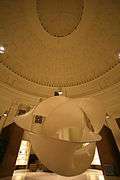Robert Engman
Robert Engman (born April 29, 1927[1] in Belmont, Massachusetts) is an American sculptor with a number of works in the Hirshhorn Museum,[2] and elsewhere in the US.
Life
Engman was born in 1927 to parents who had emigrated from Sweden. He joined the Navy at the age of 15, serving in World War II in the Pacific. He graduated from the Rhode Island School of Design with a BFA, and from Yale University with an MFA in 1955, in Painting and in Sculpture, where he studied with Josef Albers.[3] Albers wrote of him: “Only a few independent ones were courageous enough to concentrate on the plane—the in-between of volume and line—as a broad sculptural concept and promise.”[4]
Engman has taught sculpture at Yale University, and at the University of Pennsylvania ("Penn").
Works
Students collaborated with Engman to create the Peace Symbol (1967) sculpture which was installed in front of the Van Pelt Library at Penn in 1983.[5]
One of his best-known sculptures, Triune (1975), stands at the southwest corner of Philadelphia City Hall.[5] Another work, Kings (1975) is at 78th and Lindbergh Streets, also in Philadelphia.[5]
In his work, he often explores minimal surface intersections of geometric forms. Others have been fascinated with the science and mathematics of such surfaces, including the late R. Buckminster Fuller.[6]
- Peace Symbol (1967) was created in collaboration with Penn students

- Triune (1975), near Philadelphia City Hall
References
- ↑ https://www.mylife.com/robert-engman/kelseyanders1
- ↑ http://hirshhorn.si.edu/search.asp?search=Engman
- ↑ Column, 1963, Public art at Yale
- ↑ "Robert Engman" (PDF). List Visual Arts Center. MIT. Retrieved 2017-03-19.
- 1 2 3 http://culturenow.org/entry&permalink=08415&seo=Peace-Symbol_Robert-Engman-and-University-of-Pennsylvania
- ↑ Robert Engman page, Philadelphia Public Art @ philart.net
- ↑ "CultureNOW - Untitled: Robert Engman and MIT Public Art Collection". culturenow.org. Retrieved 2017-03-19.